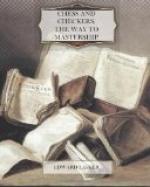In most of these cases some pieces are on the board in addition to the Pawns and sometimes it is only by their exchange that the game can be won. The most elementary example is that shown in the following Diagram.
+---------------------------------------+ 8 | | | | | | | | | |---------------------------------------| 7 | | | | | | | | | |---------------------------------------| 6 | | | | | | | | | |---------------------------------------| 5 | | | | | | | | | |---------------------------------------| 4 | #Q | | | | ^P | | | | |---------------------------------------| 3 | | #K | | | | | | | |---------------------------------------| 2 | | | | | | | | | |---------------------------------------| 1 | | | ^Q | | | | ^K | | +---------------------------------------+ a b c d e f g h
Diagram 14.
White is a Pawn ahead and it will be his object to Queen it. The beginner, in his haste to advance the Pawn, will probably play P-e5 at once and lose the Pawn, as Black can answer Q-d4 check with simultaneous attack on the Pawn. The correct way to play for White is (1) Q-d1+, K-a3 or b4; (2) Qxa4, Kxa4. Now that the Queens are exchanged White need not any longer worry about any interference with his plans to queen the Pawn except maneuvers of the black King, which might still lead to the capture or the blockade of the Pawn.
A rash advance of the Pawn would again be the wrong thing. The right way of playing is indicated by a simple calculation. The Pawn needs four moves to reach the queening square. But the black King arrives there in the same number of moves, so that he can capture the Pawn the moment he queens. Consequently White will only be able to enforce the safe queening of his Pawn if he can gain control of the queening square with his own King, thus protecting the Pawn at the time of queening.
Now, White needs three moves to bring his King up to his Pawn on f4. In the meantime Black will have reached the square d6 and after White’s (4) K-f5 Black will block the further advance of White’s King by K-e7. However, White can force Black to give the way free. The maneuver by which he does this is one which occurs in a similar form in nearly all Pawn endings and its thorough grasp is therefore essential. Diagram 15 shows the critical position.
+---------------------------------------+ 8 | | | | | | | | | |---------------------------------------| 7 | | | | | #K | | | | |---------------------------------------| 6 | | | | | | | | | |---------------------------------------| 5 | | | | | | ^K | | | |---------------------------------------| 4 | | | | | ^P | | | | |---------------------------------------|




